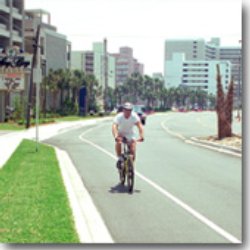South Carolina Bicycling and Walking Resolution
State of South Carolina
Source: Pedestrian and Bicycle Information Center (PBIC)
Problem
South Carolina needed to increase elected leaders' support for pedestrian and bicycle improvements.

Solution
The SCDOT, under the leadership of the Executive Director Elizabeth S. Mabry, formed a statewide Advisory Committee on Bicycle and Pedestrian Facilities to help guide the Department of Transportation in providing walking and bicycling facilities. The committee was composed of a diverse number of organizations, including the State Senate, House of Representatives, several state government departments, the AARP of South Carolina, the Palmetto Conservation Organization (sponsor of a local trail initiative), two different prominent state employers, and several organizations promoting physical activity or child safety and education. Through this Committee a vision for the state was developed, and a practical strategy for getting there was conceived.
Second, the Department of Transportation, in partnership with the South Carolina Division Office of the Federal Highway Administration sponsored the first state conference focusing on pedestrian and bike issues called "Transportation Choices for the 21st Century." Over 350 people attended, including state employees, community leaders, interest groups, and planning professionals. Participants learned from communities with success in their own towns.
Following the success of the conference, the South Carolina Transportation Commission approved a resolution affirming that bicycling and walking accommodations should be a routine part of the Department's planning, design, construction, and operating activities, and would be included in the everyday operations of its transportation system. The resolution recognized that "increasing walking and bicycling offers the potential for cleaner air, greater health of the population, reduced traffic congestion, more livable communities, less reliance on fossil fuels and their foreign supply sources, and more efficient use of road space and resources."
The only cost was $100,000 programmed as a Transportation Enhancement Project to cover any costs of the Conference not born by registrations and exhibitor fees. Another $1500 was also donated towards the conference by the cosponsor, Norman J. Arnold School of Public Health at the University of South Carolina. Members of the Advisory Committee donated their time from their various organizations so that meetings were not considered a public cost.
Results
In the months since the conference, a new citizens' pedestrian task force formed in Anderson, and the preexisting pedestrian groups have new inspiration. Project designers are more cognizant of pedestrian facilities in projects and in mitigating some aspects of projects that are adverse to pedestrians. There has been an increased interest in providing pedestrian facilities; dozens of rural Transportation Enhancement projects were recently proposed to provide sidewalks, trails, or streetscapes to aid pedestrian safety and accommodation.
Contact
The South Carolina Department of Transportation
955 Park Street
P.O. Box 191
Columbia, SC 29202-0191
(803) 737-2314
shealyse@scdot.org
Image Source
South Carolina Department of Transportation. www.scdot.org




